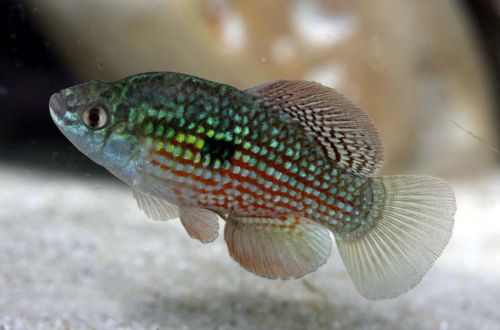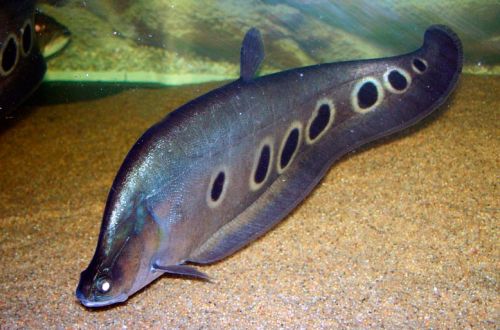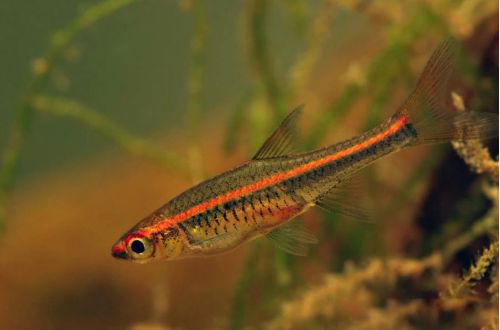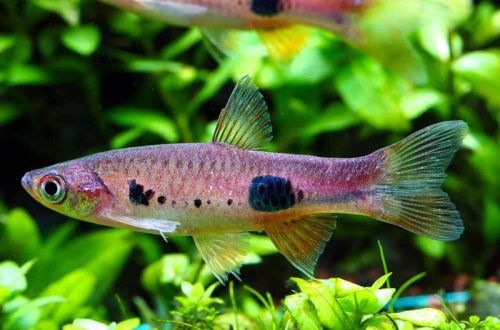
Florida
The Florida or American Flagfish, scientific name Jordanella floridae, belongs to the Cyprinodontidae family. A beautiful small fish native to the southern US state of Florida, has an amazing resemblance in color to the American flag (horizontal red and white stripes), from which it got its second name.

This species has been successfully bred in home aquariums for many years, so it managed to adapt to various conditions and water parameters, sometimes significantly different from the natural reservoirs of the sunny southern state. Perfect for beginner aquarists.
Gnáthóg
Endemic to the Florida peninsula in the United States. It lives in numerous small lakes, creeks, swamps, and is often found in ordinary ditches and agricultural water channels.
Tuairisc
Elongated body with rounded fins. Adult males have larger dorsal and anal fins than females and are more colorful. The body pattern consists of horizontal alternating stripes of red/red-brown and silver/blue-green. The back behind the head is yellow, in the center of the body there is a noticeably dark rounded spot.
Bia
They prefer meat feed from daphnia, bloodworms, small worms, but they will also accept any high-quality dry food (flakes, granules) containing protein components. A combination of dry and live/frozen food is recommended. Herbal supplements in the form of spirulina flakes or other algae are required.
Feed 2-3 times a day in the amount eaten in a few minutes, all uneaten food residues should be removed to avoid water pollution.
Cothabháil agus cúram
A group of fish will require a spacious tank of about 100 liters, although an aquarium of 50 liters or more will be useful for one pair. In the design, the main emphasis is on plants, there should be a lot of them, both root and floating, the latter can cover almost the entire surface of the water. Give preference to hard-leaved species. The soil is usually used sandy, various snags, fragments of tree roots, etc. are installed as decoration.
Florida fish are adapted to various water parameters and are even able to feel comfortable in slightly salty water, which in the wild often enters their reservoirs during hurricanes and typhoons. This feature greatly facilitates the preparation of water to fill the aquarium. It is enough to use ordinary tap water, previously settled for a couple of days to remove chlorine.
The minimum set of equipment is standard: a filter, an aerator, a lighting system, a heater, it is quite possible to do without the latter if the temperature in the room does not fall below 20–22 degrees.
Weekly maintenance consists in replacing part of the water (10–20%) with fresh water. If necessary, the soil is cleaned of organic waste (excrement, food debris, fallen plants or their parts, etc.), the glass is cleaned of plaque.
Oibriú
Males are belligerent towards each other, this is especially pronounced during the mating season, they need their own territory, therefore it is recommended to keep 50 pair in a small aquarium (1 liters). However, in much larger tanks (from 100 liters) it is quite possible to arrange a community of several males, provided that each has its own space, an area of the aquarium.
With regard to other species, you should be careful, small fish will be subjected to aggression from Florida males, as well as larger, but peaceful neighbors. It is preferable to keep in a species aquarium or together with some types of catfish.
Pórú / pórú
There is a misconception, including in a number of some scientific papers, that Florida fish breed by creating hole nests in the ground and protecting offspring. The reality is somewhat different.
Spawning usually takes place in spring or late summer. During this period, the male defines a temporary territory, which he carefully defends from rivals and attracts females with the help of a bright outfit. The female, having chosen a partner, lays a batch of eggs on the leaves and/or stems of root plants, the male immediately fertilizes them. This is where parenting ends before it starts.
The eggs are left to themselves. Often, parents eat their offspring, so it is more advisable to remove them to a separate tank, for example, a three-liter jar. The incubation period lasts from 7 to 14 days depending on the water temperature. The newly hatched fry feed on brine shrimp nauplii, microworms and other microfoods.





